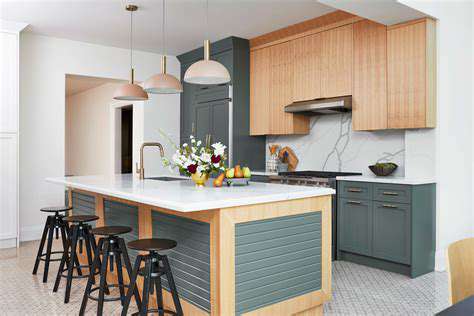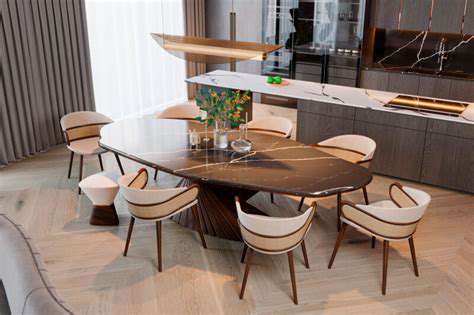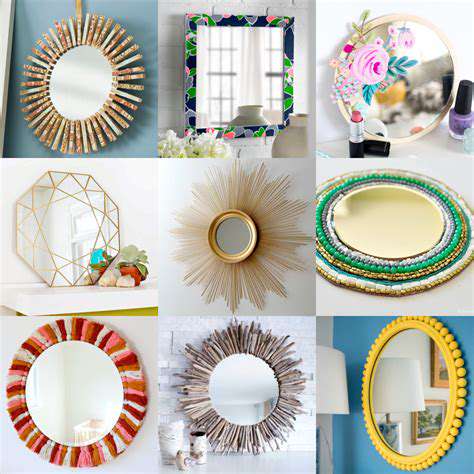Guide to Choosing the Perfect Rug for Your Space
Assessing Room Dimensions
Understanding the dimensions of your space is crucial when selecting a rug. A rug that's too small will make a room feel cramped and unfinished, while one that's too large can overwhelm the space, drawing attention away from other key features. Measure the length and width of the room, including any alcoves or irregular shapes, to get an accurate representation of the available floor space. Consider how the rug will fit within the existing furniture arrangement, ensuring there's enough space around the rug for comfortable movement and visual balance.
Considering Room Shape and Layout
The shape of your room plays a significant role in rug selection. A rectangular room might benefit from a similarly shaped rug, while a more irregular or oddly shaped room might call for a rug that accentuates or complements the room's unique characteristics. If the room has a focal point, such as a fireplace or seating area, consider how the rug can enhance that feature. Consider the arrangement of furniture and how the rug can visually connect different elements in the room.
Understanding Furniture Placement
How your furniture is arranged within the room significantly impacts the rug's size and placement. Ensure that the rug extends beyond all primary furniture pieces, such as sofas and chairs, by a few inches on all sides. This creates a sense of spaciousness and allows for easy movement around the furniture. Consider how the rug will visually connect the furniture pieces, and how it will support the overall aesthetic and flow of the room.
The Importance of Traffic Flow
Traffic flow within a room dictates the rug's durability and material. high-traffic areas, like hallways or entryways, require rugs with more robust construction. Look for rugs made from durable materials like wool or jute, and consider rugs with a high-density pile to minimize wear and tear. Rug placement should also support smooth traffic flow, avoiding tripping hazards and ensuring easy navigation around furniture and other objects.
Considering Room Decor and Style
The overall decor and style of your room should influence your rug selection. A modern room might benefit from a minimalist rug with clean lines, while a traditional room could be enhanced by a patterned or textured rug. Consider the colors and patterns already present in the room and choose a rug that complements them without overpowering the space. A rug can act as a focal point or a subtle accent, depending on the design intent.
Material and Durability for Everyday Use
Different rug materials offer varying levels of durability and maintenance. Consider the lifestyle of your home and the amount of foot traffic in the room. For high-traffic areas, opt for rugs made from durable materials like wool, jute, or polypropylene. These materials are known for their stain resistance and ability to withstand everyday use. If you have pets or children, prioritize rugs with stain-resistant properties and easy-to-clean surfaces.
Matching Rugs to Your Personal Style
Ultimately, the rug you choose should reflect your personal style and preferences. Consider the overall aesthetic of the room and the type of atmosphere you want to create. Do you prefer bold patterns or neutral colors? Do you gravitate towards traditional or contemporary designs? Selecting a rug that aligns with your personal taste will ensure that the space feels inviting and uniquely yours. This personal touch will transform your room from functional to beautiful.

Color and Pattern: Reflecting Your Style
Choosing the Right Color Palette
Color plays a crucial role in setting the mood and aesthetic of a room. When selecting a rug, consider the existing color scheme in your space. A rug with a complementary color palette can enhance the existing design, creating a cohesive and visually appealing environment. For example, a deep teal rug can add a touch of sophistication to a room decorated in neutral tones, while a vibrant orange rug can inject a burst of energy and personality into a more subdued space. If you're working with a bold or patterned wall or furniture, a more muted rug can help balance the room and prevent it from feeling overwhelming.
Conversely, a rug that contrasts sharply with the existing color scheme can create a dramatic focal point. A rich, burgundy rug in a room dominated by lighter colors can instantly elevate the room's sophistication. Carefully consider the impact of color on the overall atmosphere. A calming blue rug can promote relaxation, while a warm yellow rug can evoke feelings of happiness and cheerfulness. Understanding the psychological effects of color can help you select a rug that perfectly complements your personal style and desired ambiance.
Patterns for Personality and Function
Rug patterns offer a diverse range of options to express your unique style and create visual interest within a room. A geometric rug can add a modern and contemporary feel, while a floral pattern can evoke a sense of elegance and sophistication. Abstract designs can inject a touch of creativity and intrigue, while animal print rugs can add a touch of boldness and character. Consider the scale of the pattern in relation to the room's size; a large-scale pattern in a small room can overwhelm the space, while a subtle pattern in a large room might appear lost or underwhelming.
Beyond aesthetics, consider the practicality of the pattern. A rug with a high-contrast pattern might be easier to clean if dirt and stains are less noticeable. A solid-colored rug, on the other hand, might be a more practical choice if you have pets or children. Ultimately, the choice of pattern should reflect your personal preferences and the overall style of your home. Consider the overall balance between the rug's pattern, the room's existing decorations, and the specific feel you are looking to achieve.
The pattern choice is also influenced by the room's function. A high-traffic area, like a hallway or entryway, might benefit from a durable, neutral rug with a subtle pattern to prevent the pattern from showing wear and tear quickly. In a more intimate space, like a bedroom, a more elaborate pattern can be a beautiful focal point.
A rug with a bold, repeating pattern can add a touch of whimsy to a living room. Similarly, a rug with a subtle, textured pattern can add depth and dimension to a dining area. The right pattern can not only visually enhance a room but also improve its functionality and comfort.
A rug with a textured, woven pattern can add a touch of warmth and sophistication to a living room. The choice of pattern should be carefully considered to ensure that it complements the room's existing décor and enhances the overall aesthetic.
Consider Your Lifestyle and Budget
Considering Your Lifestyle
When selecting a rug, carefully consider your lifestyle. A high-traffic area, like a hallway or entryway, requires a rug that can withstand frequent foot traffic and spills. Durable materials like wool or synthetic fibers are ideal for these spaces. If you have young children or pets, a rug with stain-resistant properties is crucial. A plush, soft rug might be perfect for a quiet reading nook, but not as practical for a family room with active children. Understanding your daily routine and the amount of foot traffic the rug will experience will greatly influence your choice.
Think about how you interact with the space. Is it a place for relaxation, or more of a hub for activity? A thick, plush rug promotes relaxation, while a more patterned or textured rug can add visual interest and a focal point to a room. Your personal style and the overall aesthetic of the room should also inform your decision. A modern, minimalist space might call for a simple, geometric rug, while a more traditional room could benefit from a patterned or textured rug.
Budgeting for Your Rug
Setting a budget is essential for finding the perfect rug that fits your needs and financial constraints. Consider the size and quality of the rug. Larger rugs often come with a higher price tag due to the increased material and labor costs. Luxury materials like hand-knotted wool rugs tend to command a higher price point. Explore different price ranges to find a rug that's both stylish and affordable. Don't be afraid to shop around and compare prices from various retailers.
It's important to weigh the cost against the rug's lifespan and its ability to enhance the room's aesthetic appeal. A durable, high-quality rug will last longer, making it a worthwhile investment in the long run. A less expensive rug might require replacement sooner, but it can still fulfill a functional need within a certain budget. Knowing your budget will help narrow your search and prevent overspending.
Measuring and Planning Your Space
Before you start shopping, accurately measure the space where you intend to place the rug. This crucial step ensures a well-proportioned and aesthetically pleasing rug placement. Taking precise measurements helps you avoid purchasing a rug that's too small or too large for the area. A rug that's too small can make a room feel cramped, while a rug that's too large can visually overwhelm the space. Consider the furniture arrangement within the room to determine how much space the rug will occupy.
Think about the layout of furniture and how it relates to the rug. A rug that extends beyond the furniture often creates a sense of visual harmony and draws the eye to the area. If the rug is placed under a dining table, it should extend several inches beyond the table's edges on all sides. A rug in a living room should be large enough to accommodate seating areas and provide ample space for movement. Planning the rug's size and placement is an important part of achieving the desired aesthetic.
Beyond the Basics: Adding Texture and Personality

Exploring Different Textures
Adding texture to your writing goes beyond simply describing objects; it's about evoking a sensory experience for the reader. Consider the feel of a rough stone, the smoothness of silk, or the crispness of autumn leaves. These tactile details bring your writing to life and make it more engaging. By incorporating diverse textures, you can create a richer and more memorable narrative.
Think about how texture can affect mood and atmosphere. A description of rough, jagged rocks might evoke a sense of danger or isolation, while a description of soft, fluffy clouds could create a feeling of peace and tranquility. Understanding these connections will help you use texture effectively in your writing.
Using Sensory Details
Texture is intrinsically linked to other senses. When you describe a rough surface, you might also mention the sound it makes when touched, or the way it feels against your skin. This multi-sensory approach deepens the reader's immersion in the scene.
For example, instead of just saying the fabric was soft, you could say the fabric, like spun moonlight, felt impossibly soft against her skin, whispering a quiet promise of comfort. This more detailed description engages multiple senses, making the experience more vivid.
Creating Contrast
Using contrasting textures can heighten the impact of your writing. Imagine a scene where a smooth, polished floor meets a rough, uneven wall. This contrast creates visual interest and emphasizes the different elements of the scene.
Contrast can be used to highlight key details and create a sense of drama. For instance, describing the harsh, abrasive texture of a desert landscape against the delicate softness of a desert flower emphasizes the resilience and beauty of the flower.
Adding Depth to Descriptions
Detailed descriptions of texture add depth and complexity to your prose. Instead of simply stating that a building is old, you could describe the worn, cracked paint peeling from the weathered wood, creating a richer and more evocative image. These details provide a more complete picture for the reader.
Integrating Texture into Narrative
Don't just focus on visual textures; consider how textures affect the narrative flow and character development. If a character is constantly touching rough, worn fabrics, it could reveal something about their past or their current state of mind.
Similarly, the texture of the words you choose can affect the tone and pacing of your story. Imagine the difference between a story told in flowing, lyrical prose and one filled with harsh, choppy language. These distinct textures will impact the reader's experience, and this can be an effective tool for conveying mood and emotion within your writing.
Texture and Figurative Language
Textures can be a powerful tool for figurative language. Metaphors and similes based on texture can add layers of meaning to your writing, making it richer and more impactful. Imagine describing a person's voice as rough and gravelly, or a relationship as smooth and harmonious. These descriptions create vivid imagery and enhance the reader's understanding.
By using these techniques, you can elevate your writing beyond simple descriptions and create a truly immersive experience for your readers. Mastering the use of texture can significantly improve the quality of your writing.







![Best Bedroom Furniture Sets [Review]](/static/images/31/2025-05/ContemporarySets3ABlendingStyleandFunctionality.jpg)



